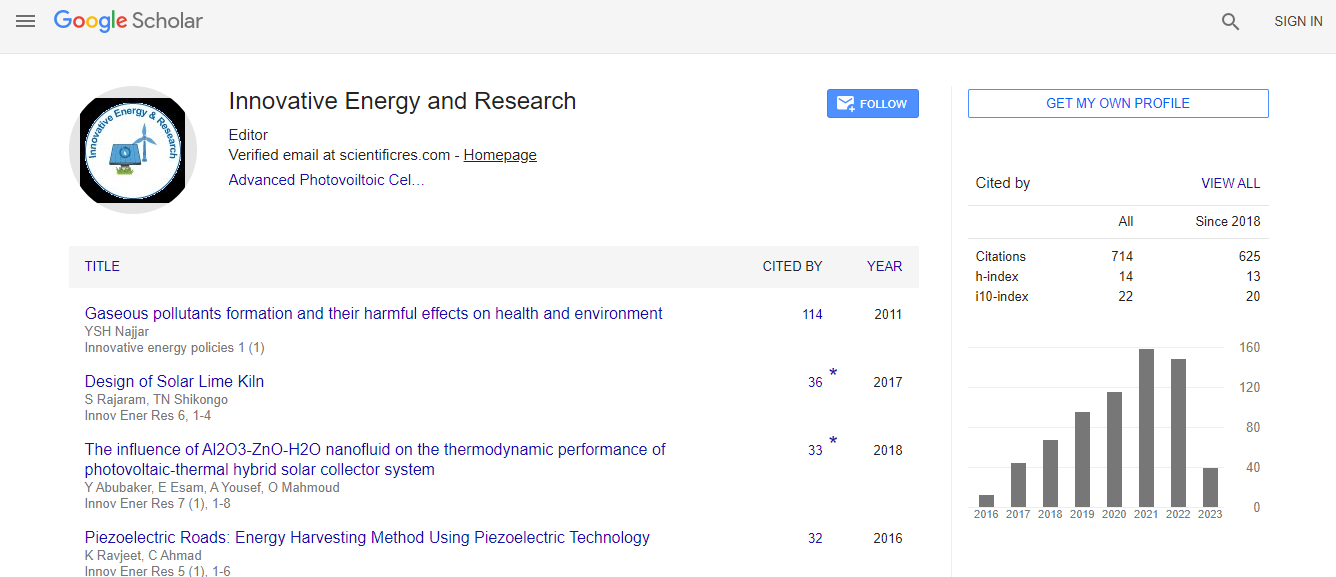Our Group organises 3000+ Global Conferenceseries Events every year across USA, Europe & Asia with support from 1000 more scientific Societies and Publishes 700+ Open Access Journals which contains over 50000 eminent personalities, reputed scientists as editorial board members.
Open Access Journals gaining more Readers and Citations
700 Journals and 15,000,000 Readers Each Journal is getting 25,000+ Readers
Google Scholar citation report
Citations : 712
Innovative Energy & Research received 712 citations as per Google Scholar report
Innovative Energy & Research peer review process verified at publons
Indexed In
- Google Scholar
- Open J Gate
- Genamics JournalSeek
- RefSeek
- Hamdard University
- EBSCO A-Z
- Publons
- Euro Pub
- ICMJE
Useful Links
Recommended Journals
Related Subjects
Share This Page
A framework for critically assessing the ideality of carrier-selective contacts for solar cells
21st International Conference on Advanced Energy Materials and Research
Gabriel J Man
Uppsala University, Sweden
ScientificTracks Abstracts: Innov Ener Res
Abstract
The simplest solar cell consists of a light absorber, sandwiched between two metals with dissimilar work functions. Carrier-selective contacts (CSC’s), which are ubiquitous in modern solar cells, are added to improve the electrical performance. The proper design and implementation of a CSC is crucial, as the performance, lifetime, and/or cost reduction of a solar cell can be hampered by a single interface or layer. A framework, consisting of eight core requirements, was developed from first-principles to evaluate the effectiveness of a given CSC. The framework includes some requirements which are well-recognized, such as the need for appropriate band offsets, and some requirements which are not well-recognized at the moment, such as the need for effective valence/conduction band density of states matching between the absorber and CSC. The application of the framework to multiple siliconbased CSC’s revealed the difficulties of effectively designing and implementing a CSC. Three metal oxide/silicon heterojunctions - titanium dioxide/silicon (TiO2/Si), zinc oxide/silicon (ZnO/Si), and tin dioxide/silicon (SnO2/Si) - initially expected to yield similar electron-selective contacts (ESC’s) were instead discovered to be widely different in terms of their suitability as an ESC.Recent Publications
1. G J S Man (2017) Metal oxide/semiconductor heterojunctions as carrier-selective contacts for photovoltaic applications. Princeton University.
2. G Man, J Schwartz, J C Sturm and A Kahn (2016) Electronically passivated hole-blocking titanium dioxide/ silicon heterojunction for hybrid silicon photovoltaics. Adv. Mater. Interfaces 3(15):1600026.
3. K A Nagamatsu et al., (2015) Titanium dioxide/silicon hole-blocking selective contact to enable doubleheterojunction crystalline silicon-based solar cell. Appl. Phys. Lett., 106(12): 123906.
4. G Sahasrabudhe et al., (2015) Low-Temperature Synthesis of a TiO2 /Si Heterojunction. J. Am. Chem. Soc., 137(47):14842–14845.
5. S Avasthi, W E McClain, G Man, A Kahn, J Schwartz and J C Sturm (2013) Hole-blocking titanium-oxide/silicon heterojunction and its application to photovoltaics. Appl. Phys. Lett., 102(20):203901.
Biography
Gabriel Man has worked as a Postdoctoral researcher in the Division of Molecular and Condensed Matter Physics at Uppsala University since April 2018. In his current work, he applies and develops X-ray spectroscopic techniques to gain fundamental understanding of the relationships between the crystal and electronic structures of advanced energy materials. His work spans both fundamental and applied science, and is guided by his background in engineering and technology entrepreneurship. Prior to his postdoctoral appointment, Gabriel spent nearly a year working in industry as a device engineer/physicist at a thin film solar cell startup company. Gabriel received his PhD in 2017 in Electrical Engineering and Materials Science from Princeton University (New Jersey, USA) under the supervision of Prof Antoine Kahn. His PhD research was partially supported by a prestigious PhD fellowship from the Natural Sciences and Engineering Research Council of Canada (NSERC), and by a fellowship from Princeton University.
E-mail: gabriel.man@physics.uu.se

 Spanish
Spanish  Chinese
Chinese  Russian
Russian  German
German  French
French  Japanese
Japanese  Portuguese
Portuguese  Hindi
Hindi 
